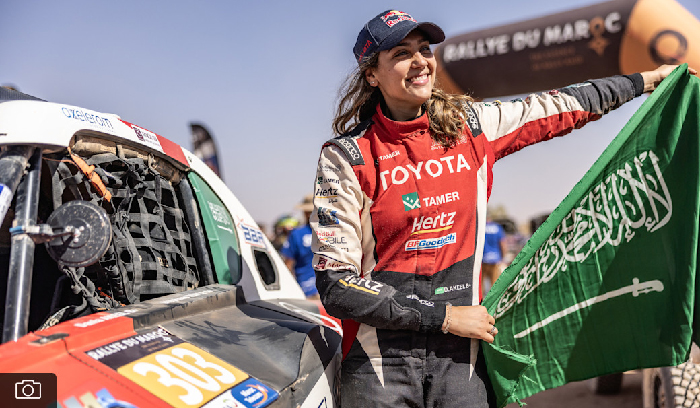Saudi Arabian rally driver Dania Akeel, a rising star in the motorsport world, has shared how her first exposure to the Dakar Rally as a spectator helped shape her journey to becoming a top-10 finisher in one of the most grueling events in motorsport. Now preparing for her fourth professional Dakar Rally in 2025, Akeel reflects on the insights she gained from her initial role at the Dakar, offering valuable lessons for both aspiring competitors and fans alike.

80/20 Summary:
- Dania Akeel, a top-10 finisher in the Dakar Rally, is Saudi Arabia’s first female competitor in the race. She’s preparing for her fourth Dakar in 2025.
- Akeel initially visited the Dakar Rally in 2021 as a spectator, invited by the Saudi Automobile and Motorcycle Federation to assist with social media. This role allowed her to learn the intricacies of the rally, including its logistics and operations.
- Key learning moments included discovering the bivouac setup, where identical camps travel with the rally, and receiving advice from Jutta Kleinschmidt, the first woman to win the Dakar, who told her: “In the dunes, just keep moving.”
- Akeel emphasizes the importance of observing different driving techniques and how watching the rally helped her mentally prepare for competition.
- The Dakar bivouac is described as a “moving village” where competitors and teams interact in a nostalgic, human-focused environment.
- Saudi Arabia is praised as an ideal location for the Dakar due to its diverse terrain, including sand dunes, rocks, and gravel. The 2025 Dakar Rally will cover 7,759 kilometers across 12 stages, starting in Bisha and ending in Shubaytah.

Deep Dive:
Akeel’s deep-rooted curiosity and educational background—holding degrees in modern history, politics, and international business—set the stage for her methodical approach to rallying. Rather than jumping straight into competition, she took time to study the inner workings of the event in 2021, when she was invited by the Saudi Automobile and Motorcycle Federation to assist with social media during the Dakar Rally.

First Impressions of the Dakar Rally
During her time as a spectator, Akeel observed the intricacies of the event and the vast logistics involved in moving the rally over 8,000 kilometers in 12 days. The most striking discovery, she recalls, was how the rally’s two bivouacs (competitor camps) are set up identically, down to the finest details, reinforcing the immense planning that goes into each stage.
“On my first visit, I found out that there are actually two bivouacs travelling with the rally. There’s the bivouac where we wake up to start that day’s stage, and then another, absolutely identical bivouac set up at our destination. The level of planning is incredible,” said Akeel.

Learning from Dakar Legends
One of the most impactful moments of her early Dakar experience came from a conversation with Jutta Kleinschmidt, the first female winner of the Dakar Rally. Akeel describes Kleinschmidt as an inspiration, both for her professionalism and passion for the sport.
“I told Jutta that the dunes scared me. She told me, ‘In the dunes, Dania, just keep moving. Just keep moving!’ I remind myself of that advice all the time,” Akeel said.
This advice, paired with her observations of various competitors’ driving techniques, was crucial to Akeel’s understanding of the mental and physical demands of the race.
The Dakar Bivouac: A Microcosm of the Race
Describing the Dakar bivouac as a “moving village,” Akeel emphasized how the atmosphere fosters camaraderie among competitors and teams, despite the intense pressures of the race.
“People help each other, share news, and stay connected face-to-face. It’s like a throwback to a simpler time,” Akeel added. “But yes, I definitely get lost there! It’s huge, and everything looks the same!”
The 2025 Dakar Rally: Akeel’s Next Challenge
Akeel, who has already achieved a top-10 finish in the Dakar, is preparing for her fourth professional start in the 2025 event, which kicks off on January 3. Saudi Arabia, where the Dakar has been held for the past five years, offers a diverse range of terrain—from sand dunes and rocks to gravel and desert—making it an ideal location for the world’s toughest rally.
“The terrain in Saudi Arabia is incredibly diverse. You’ve got sand, rocks, gravel, and dunes—everything a driver needs to sharpen their skills,” Akeel says. “It’s a stunning country, and the diversity of its terrain makes it a perfect match for the Dakar. It’s not just a race—it’s an adventure.”
The 2025 Dakar Rally will cover 7,759 kilometers over 12 timed special stages, beginning in Bisha and finishing in Shubaytah. The rally is more than just a race – it’s a journey of resilience, strategy, and sheer determination, with seasoned pros, rising stars, and pioneers of eco-friendly technology all vying for victory.

COMMENTS